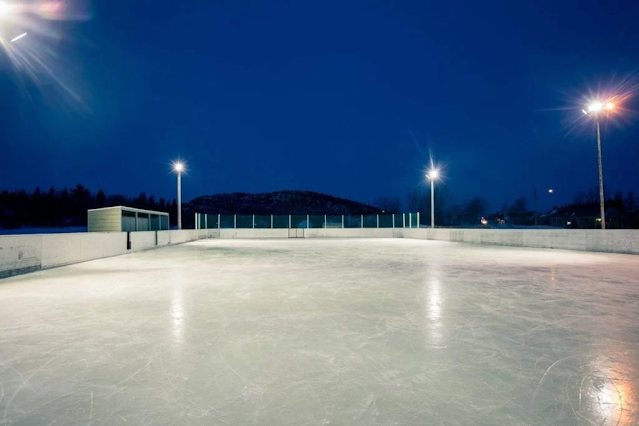Skating Locator
How Does an Ice Rink Stay Frozen?
I think just about everyone has asked the question about how ice skating rinks stay frozen. I did some research and here’s what I found out.
So how does an ice rink stay frozen? Ice rinks are made by chilling a slab of concrete below the ice with an ice rink refrigeration system. This refrigeration system consists of miles of piping that pump cold glycol through the concrete to keep it at the appropriate temperature, making sure the ice stays frozen.
This seems like an especially difficult task in areas were the temperature stays warm year round. The system for keeping ice rinks frozen is quite fascinating.
How Does an Ice Rink Chiller Work?
The first part of the process includes a large filtration system that creates deionized water. This process is pivotal for making clear ice that will become the surface of the ice rink.
Next, there is an ice rink refrigeration system that consists of a chiller, approximately five miles of steel, and antifreeze-like brine water that prevents frozen pipes.
An ice rink has many layers to it, starting from the bottom and working to the top until you have a frozen ice skating surface:
- ice skating surface
- top concrete slab
- insulation
- bottom concrete slab
- sand and gravel base
The bottom concrete slab is heated to keep the ground from freezing and potentially cracking the rink surface or structure. Steel pipes wind back and forth under the rink, removing heat from the bottom concrete slab.
The ice rink chiller equipment pumps approximately 16°F brine water through the pipes. This brine acts like antifreeze to keep the pipes from freezing. After water circulates through about 5 miles of steel pipe, it is then pumped into steel pipes that are embedding in the top concrete slab.
This brine water keeps the top concrete slab temperature around 0°F, making it the perfect surface for water to freeze on.
The layer of insulation between the bottom layer of concrete and the top layer of concrete allows the skating surface to expand and contract as needed. Time and outdoor temperature changes could cause unexpected expansion or contracting, so the insulation acts as a barrier.
At the very bottom on the rink, there is a layer of sand and gravel which holds a drainage pipe for groundwater.
When it comes time to defrost or remove the ice to use the facility for other events, the brine water is simply heated. The ice can eventually be broken up and removed with an end loader.

Once the ice rink refrigeration system is set up and the pipes have cooled the top concrete slab to 0°F, very thin layers of water are pumped onto the surface of the concrete. It takes a minimum of 12 layers of ice to get the perfect ice rink. The layers of ice work like this:
- First layer – Water pumped directly on top of the 0°F concrete at approximately 1/30 of an inch.
- Second layer – White paint that is approximately 1/30 of an inch.
- Third layer – Water pumped on top of the paint to seal in the two layers and is approximately 1/16 of an inch thick.
- Painted lines & logos– Depending on the sport, painted lines and logos are added on top of the third layer.
- Eight to ten final layers – Each layer is consistently pumped and evenly spread until the rink reaches the appropriate thickness.
Fun Fact: An ice rink takes over 10,000 gallons of water to make the skating surface!
How Do They Paint Ice Rinks?
White powdered paint is mixed with water and is applied to the surface of the ice with a large sprayer. The ice surface is covered with two or three layers of paint and then sealed with another layer of water to form an ice layer over the paint.
Next, the rink is marked out for where circles, lines, and logos should be painted. Thin lines are marked on either side of where lines should be painted. The thick colored lines are painted between the thin lines, to make the appropriate size and colored lines. Circles are painted like a protractor where someone holds the center of the circle while someone else holds the other end painting the circle. Lastly, logos are stenciled on the ice and hand painted.
Once all the lines, circles, and logos are painted more layers of ice are added on top to seal everything.How Thick is the Ice on an Ice Rink?
Water is added to the rink in thin layers and frozen each time until the thickness reaches 3/4″ to 1 1/2″. The thicker the ice, the softer and slower it becomes. Therefore, the NHL has regulation ice thickness of 3/4″.
The quality and thickness of the ice is maintained by an ice resurfacer, often referred to by the name Zamboni. A Zamboni shaves ice off the top to “clean” the surface especially after being skated on. It then lays a new 1/32″ layer of hot water (around 140°F) on the top. The heated water melts the ice just enough to smooth out and fill in any groves and scrapes created by the skates.

How Long Does it Take to Freeze an Indoor Ice Rink?
With the arena temperature at approximately 50°F and the top concrete slab at 16°F, someone will spray water on the surface of the rink with a spray wand. It takes about 8 hours to spray enough layers to get 1/2 of ice. Each layer is frozen before the next layer is put down.
At 16°F, water pretty much flash freezes when sprayed at a thickness 1/30 of an inch at a time.
Once a 1/2 inch of ice is down, the Zamboni comes out and starts laying 1/30″ layers of water at a time until the ice is the appropriate thickness. The Zamboni also scrapes off the ice where it become uneven.
Sonar depth guns are used to determine the ice depth around the rink to make sure it’s even everywhere.
It takes about four days to make an ice rink that is around one-inch thick.
How Cold are Indoor Ice Rinks?
Figure skaters and hockey players have different opinions on the temperature of ice rinks. Ice that is 26-28°F is softer and less likely to shatter when jumped on, making it desirable to figure skaters. Ice in that temperature range also gives figure skaters more grip on the skate edges.
Hockey players prefer harder, colder ice in the 24-26°F temperature range. With more skaters on the ice during a game, it’s very easy for the ice surface to get chewed up. Therefore, the ice is kept colder than what figure skaters like.
Ice that is too warm could result in a lack of grip whereas ice that is too cold could chip easily, making it pivotal to keep hockey ice rinks at the perfect temperature.
In addition to the ice temperature, it’s important that the building temperature is correct as well. The building temperature should be between 50-60°F, with about 30% humidity. With opening and closing doors, it’s important to continually monitor the temperatures and make adjustments as needed.
Humidity is also important to ice rinks and some rinks may require up to 12 dehumidifiers to keep the ice from becoming too dry. If humidity becomes too high, there is often a fog that forms over the ice.
Related Questions
How long does it take for a backyard ice rink to freeze? It takes about three days of below freezing temperatures for a backyard ice rink to freeze. It could happen quicker if you stay consistently in the 10°F range.
When should I start ice skating? Children around the age of 5 are at the perfect age to start ice skating lessons. They have the balance and coordination needed to perform certain skating moves.

